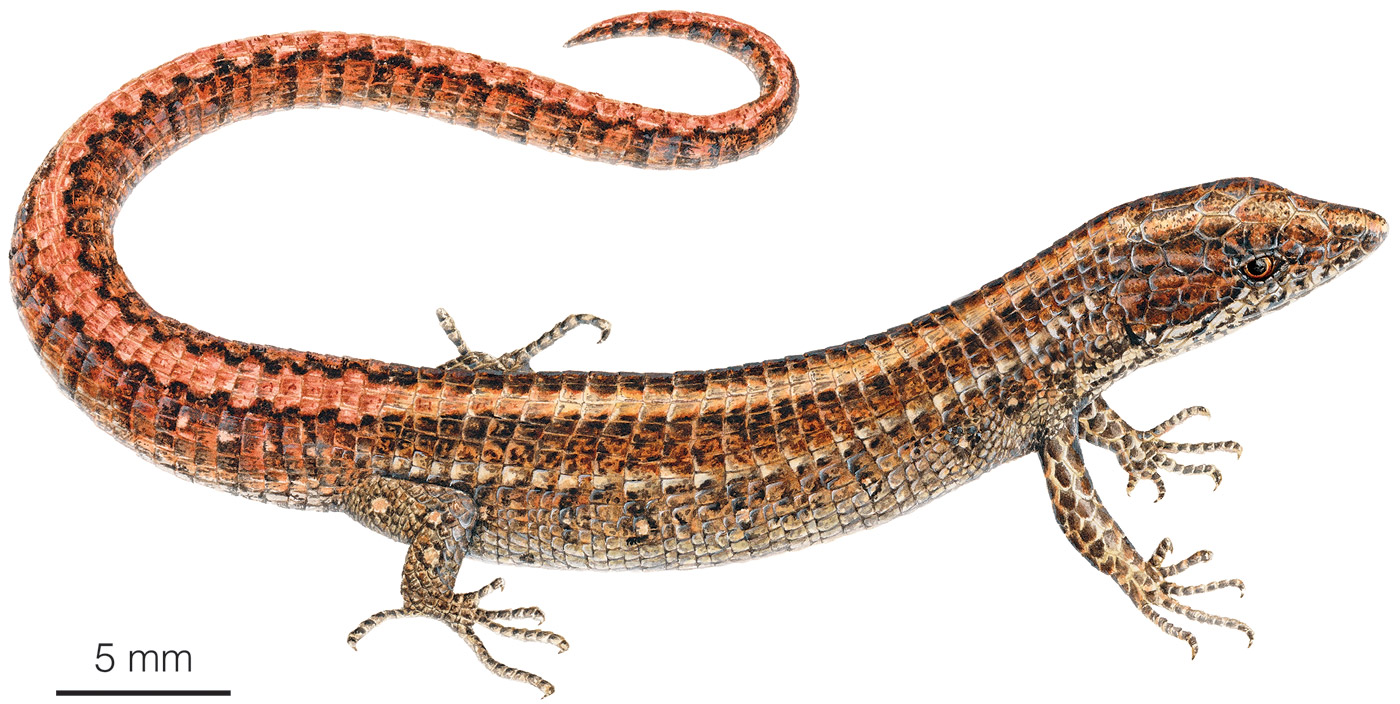Published September 21, 2023. Updated December 2, 2023. Open access. Peer-reviewed. | Purchase book ❯ |
Mama Dulu’s Microtegu (Selvasaura mamaduluae)
Reptiles of Ecuador | Sauria | Gymnophthalmidae | Selvasaura mamaduluae
English common name: Mama Dulu’s Microtegu.
Spanish common name: Microtegú de Mama Dulu.
Recognition: ♂♂ 7.9 cmMaximum distance from the snout to the tip of the tail. Snout–vent length=3.2 cm. ♀♀ 8.3 cmMaximum distance from the snout to the tip of the tail. Snout–vent length=3.4 cm..1 Forest Microtegus (genus Selvasaura) can be distinguished from other microteiid lizards by their arboreal habits, rugose dorsal scales, presence of prefrontal scales, and lower palpebral disc transparent and not divided.1–4 Selvasaura mamaduluae further differs from other lizards in its area of distribution by having a light brown dorsum with a dark-bordered cream vertebral stripe (Fig. 1), a pale line from mouth commissure to level of forearms, and a series of dark-bordered cream ocelli along the flanks.1 This species differs from S. almendarizae by having pentagonal, rather than hexagonal, frontoparietal scales. Furthermore, the two microteiids are not known to co-occur.

Figure 1: Illustration of an adult male individual of Selvasaura mamaduluae.
Natural history: Selvasaura mamaduluae is an extremely rare diurnal and arboreal lizard that inhabits pristine rainforests in foothill or mountainous areas.1 Nothing has been published about the natural history of this species, but lizards of the genus Selvasaura in general are arboreal, bromelicolous, and like to dwell in the thatch of roofs.3,4 The three known specimens of S. mamaduluae were found during the daytime at ground level in primary rainforest being destroyed for large-scale mining operations.1 Mama Dulu’s Microtegus are capable of shedding the tail as a method of defense and escape.
Conservation: Data Deficient There is inadequate information to make an assessment of extinction risk.. Selvasaura mamaduluae is a recently described species; as such, its conservation status has not yet undergone a formal evaluation by the IUCN. Here, it is proposed to be included in the DD category because there is inadequate information to make an assessment of its extinction risk based on its scarce distribution and natural history data. The species is known from just two localities separated from each other by areas having adequate forest cover, suggesting it might be present elsewhere. Unfortunately, the two localities are being cleared to make room for large-scale open-pit mining operations,5 rendering the long-term survival of the species there unlikely.
Distribution: Selvasaura mamaduluae is endemic to the Cordillera del Cóndor in southeastern Ecuador, where it is known from two localities (Fig. 2).

Figure 2: Distribution of Selvasaura mamaduluae in Ecuador. The star corresponds to the type locality: Los Encuentros, Zamora Chinchipe province. See Appendix 1 for a complete list of the presence localities included in the map.
Etymology: The generic name Selvasaura is derived from the Spanish noun selva (=forest) and the Greek saura (=lizard).4 It refers to the habitat of these lizards.4 The specific epithet mamaduluae honors Dolores Cacuango, an indigenous leader of the Kayambi people from northern Ecuador.1
See it in the wild: Species of the genus Selvasaura are among the most rarely encountered lizards in Ecuador and S. mamaduluae is no exception. Due to the species’ secretive and arboreal habits, individuals are encountered usually only by accident and no more than once every few years. The area with the greatest number of observations is Los Encuentros, where two individuals have been recorded.
Author: Alejandro ArteagaaAffiliation: Fundación Khamai, Reserva Arlequín, Ecoruta Paseo del Quinde km 56, Santa Rosa de Mindo, Pichincha 171202, Ecuador.
Academic reviewer: Jeffrey D CamperbAffiliation: Department of Biology, Francis Marion University, Florence, USA.
Illustrator: Valentina Nieto Fernández
How to cite? Arteaga A (2023) Mama Dulu’s Microtegu (Selvasaura mamaduluae). In: Arteaga A, Bustamante L, Vieira J (Eds) Reptiles of Ecuador: Life in the middle of the world. Available from: www.reptilesofecuador.com. DOI: 10.47051/ILFZ5066
Literature cited:
- Brito-Zapata D, Guayasamin JM, Parra V, Torres-Carvajal O, Reyes-Puig C (2023) A new species of microtegú (Gymnophthalmidae: Cercosaurinae) from the Cordillera del Cóndor, Ecuador. Revista Latinoamericana de Herpetología 6: 17–37. DOI: 10.22201/fc.25942158e.2023.2.575
- Torres-Carvajal O, Parra V, Sales Nunes PM, Koch C (2021) A new species of microtegu lizard (Gymnophthalmidae: Cercosaurinae) from Amazonian Ecuador. Journal of Herpetology 55: 385–395. DOI: 10.1670/20-142
- Echevarría LY, Venegas PJ, García-Ayachi LA, Sales Nunes PM (2021) An elusive new species of gymnophthalmid lizard (Cercosaurinae, Selvasaura) from the Andes of northern Peru. Evolutionary Systematics 5: 177–187. DOI: 10.3897/evolsyst.5.68520
- Moravec J, Šmíd J, Štundl J, Lehr E (2018) Systematics of Neotropical microteiid lizards (Gymnophthalmidae, Cercosaurinae), with the description of a new genus and species from the Andean montane forests. ZooKeys 774: 105–139. DOI: 10.3897/zookeys.774.25332
- Chicaiza G (2010) El enclave minero de la Cordillera del Cóndor. Acción Ecológica, Quito, 39 pp.
Appendix 1: Locality data used to create the distribution map of Selvasaura mamaduluae in Ecuador (Fig. 2). Go to the section on symbols and abbreviations for a list of acronyms used. Asterisk (*) indicates type locality.
| Country | Province | Locality | Source |
| Ecuador | Zamora Chinchipe | Concesión Mirador Norte | Brito et al. 2023 |
| Ecuador | Los Encuentros | Wild Sumaco Lodge | Brito et al. 2023 |